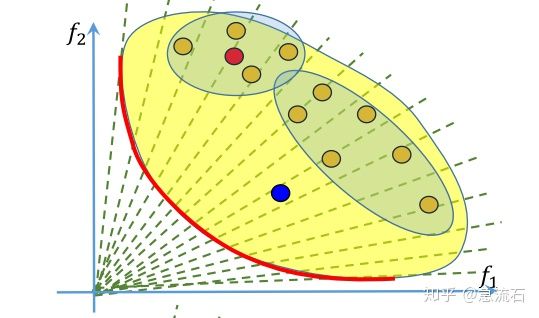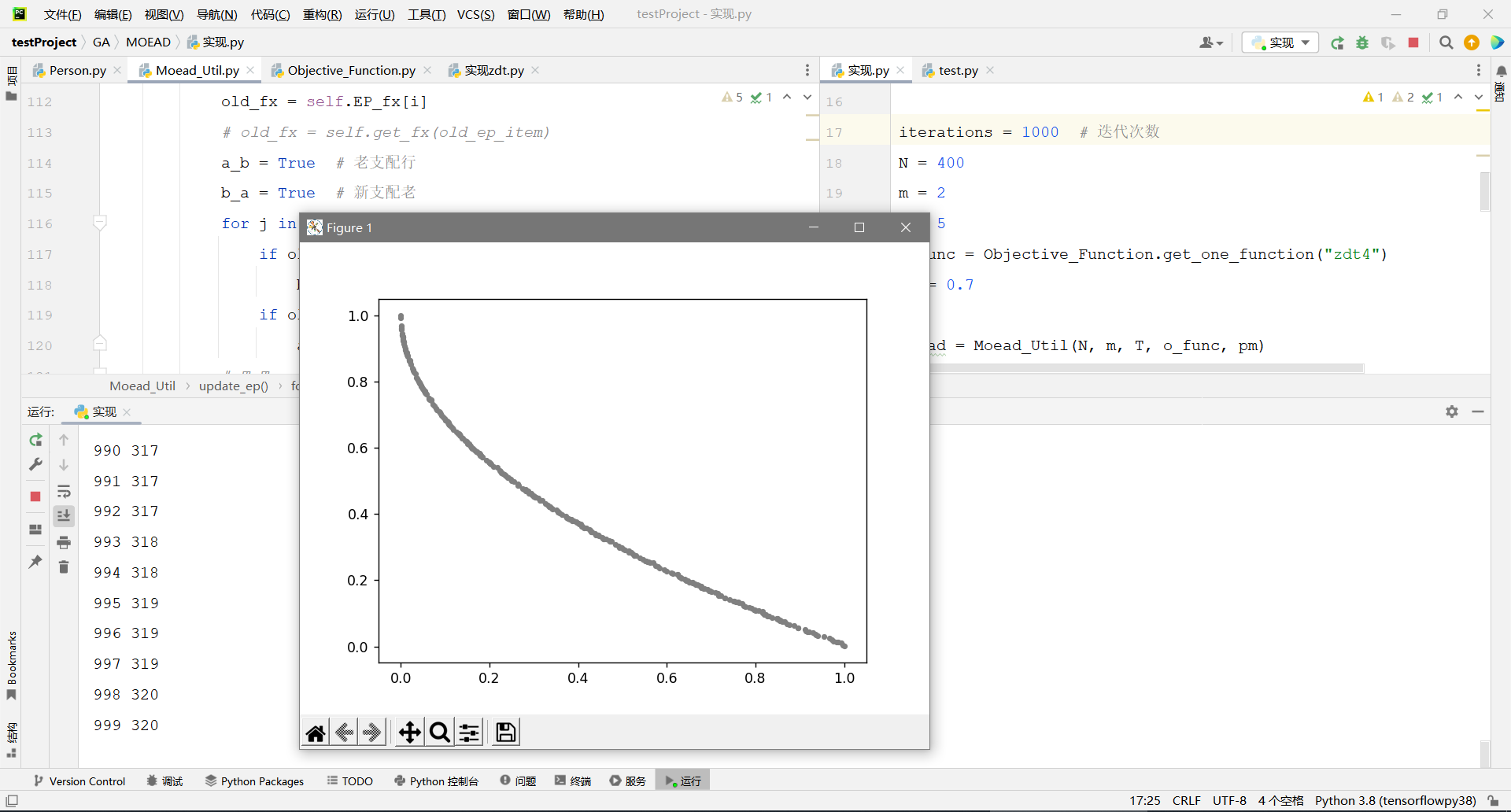MOEAD原理及Python實現、MOEAD實現、基於分解的多目標進化、 切比雪夫方法-(python完整程式碼)
2022-06-27 21:00:19
確定某點附近的點

答:每個解對應的是一組權重,即子問題,紅點附近的四個點,也就是它的鄰居怎麼確定呢?由權重來確定,演演算法初始化階段就確定了每個權重對應的鄰居,也就是每個子問題的鄰居子問題。權重的鄰居通過歐式距離來判斷。取最近的幾個。
取均勻分佈向量
https://www.cnblogs.com/Twobox/p/16408751.html
https://www.zhihu.com/question/263555181?sort=created
其中兩個回答都挺好的
1. 輸入N m # N表示取點密度 m表示問題維度 1.1 輸入 T # 表示取最近的T個作為鄰居 2. 生成均勻分佈權重向量 2.1 計算每個權重向量之間的尤拉距離 3. 權重向量個數即為:初始種群個數 4. 初始化種群,每個個體一一對應權重 4.1 更具權重之間距離,取前T個作為鄰居person 5. EP = 空 # 維護成最優前沿 6. 計算最初的全域性最優Z # 把每個帶入f1 f2中,取最小值 z1 z2 7. 開始迴圈N代 7.1對於每個個體,在領域中選取2個個體進行交叉變異,獲得2個新個體 7.1.1更新全域性解z 7.2在領域中隨機選擇2個個體,用新個與舊個體進行對比 # 新個體帶入子目標問題,直接對比值即可 7.3如果更優,則替換舊個體dna 7.4更新EP # 如果有別接收的新解,將新解與EP每一個進行比較,刪除被新解支配的,如果新解沒有被舊解支配,那麼加入EP
程式碼實現設計
# 分析 需要維護的資料結構: 某個體最近的T位鄰居: 可以考慮採用物件列表即可 均勻分佈的權重向量:一個二維ndarray陣列即可 權重向量與個體對應關係:個體物件,直接儲存權重向量陣列 權重向量之間的距離矩陣:開局初始化,不變的 EP list,裡面的個體是物件的參照 z list 目標函數集合,F list domain list # 介面設計 class Person attribute: dns:一維ndarray weight_vector: 一維ndarray neighbor: list<Person> o_func:Objective_Function 目標函數 function: mutation cross_get_two_new_dna:返回2段新dna compare#與子代比較 accept_new_dna choice_two_person:p1,p2 class Moead_Util attribute: N M T: o_func:Objective_Function pm:變異概率 EP:[dna1,dna2,..] weight_vectors:二維陣列 Euler_distance:二維陣列 pip_size Z:[] # 這裡面元素為一維ndarray陣列,即dna,即解 function: init_mean_vector:二維陣列 init_Euler_distance:二維陣列 init_population:[] init_Z:一維屬豬 update_ep update_Z class Objective_Function: attribute: F:[] domain:[[0,1],[],[]] function: get_one_function:Objective_Function
Person.py
1 import numpy as np 2 3 4 class Person: 5 def __init__(self, dna): 6 self.dna = dna 7 self.weight_vector = None 8 self.neighbor = None 9 self.o_func = None # 目標函數 10 11 self.dns_len = len(dna) 12 13 def set_info(self, weight_vector, neighbor, o_func): 14 self.weight_vector = weight_vector 15 self.neighbor = neighbor 16 self.o_func = o_func# 目標函數 17 18 def mutation_dna(self, one_dna): 19 i = np.random.randint(0, self.dns_len) 20 low = self.o_func.domain[i][0] 21 high = self.o_func.domain[i][1] 22 new_v = np.random.rand() * (high - low) + low 23 one_dna[i] = new_v 24 return one_dna 25 26 def mutation(self): 27 i = np.random.randint(0, self.dns_len) 28 low = self.o_func.domain[i][0] 29 high = self.o_func.domain[i][1] 30 new_v = np.random.rand() * (high - low) + low 31 self.dna[i] = new_v 32 33 @staticmethod 34 def cross_get_two_new_dna(p1, p2): 35 # 單點交叉 36 cut_i = np.random.randint(1, p1.dns_len - 1) 37 dna1 = p1.dna.copy() 38 dna2 = p2.dna.copy() 39 temp = dna1[cut_i:].copy() 40 dna1[cut_i:] = dna2[cut_i:] 41 dna2[cut_i:] = temp 42 return dna1, dna2 43 44 def compare(self, son_dna): 45 F = self.o_func.f_funcs 46 f_x_son_dna = [] 47 f_x_self = [] 48 for f in F: 49 f_x_son_dna.append(f(son_dna)) 50 f_x_self.append(f(self.dna)) 51 fit_son_dna = np.array(f_x_son_dna) * self.weight_vector 52 fit_self = np.array(f_x_self) * self.weight_vector 53 return fit_son_dna.sum() - fit_self.sum() 54 55 def accept_new_dna(self, new_dna): 56 self.dna = new_dna 57 58 def choice_two_person(self): 59 neighbor = self.neighbor 60 neighbor_len = len(neighbor) 61 idx = np.random.randint(0, neighbor_len, size=2) 62 p1 = self.neighbor[idx[0]] 63 p2 = self.neighbor[idx[1]] 64 return p1, p2
1 from collections import defaultdict 2 3 import numpy as np 4 5 6 def zdt4_f1(x_list): 7 return x_list[0] 8 9 10 def zdt4_gx(x_list): 11 sum = 1 + 10 * (10 - 1) 12 for i in range(1, 10): 13 sum += x_list[i] ** 2 - 10 * np.cos(4 * np.pi * x_list[i]) 14 return sum 15 16 17 def zdt4_f2(x_list): 18 gx_ans = zdt4_gx(x_list) 19 if x_list[0] < 0: 20 print("????: x_list[0] < 0:", x_list[0]) 21 if gx_ans < 0: 22 print("gx_ans < 0", gx_ans) 23 if (x_list[0] / gx_ans) <= 0: 24 print("x_list[0] / gx_ans<0:", x_list[0] / gx_ans) 25 26 ans = 1 - np.sqrt(x_list[0] / gx_ans) 27 return ans 28 29 def zdt3_f1(x): 30 return x[0] 31 32 33 def zdt3_gx(x): 34 if x[:].sum() < 0: 35 print(x[1:].sum(), x[1:]) 36 ans = 1 + 9 / 29 * x[1:].sum() 37 return ans 38 39 40 def zdt3_f2(x): 41 g = zdt3_gx(x) 42 ans = 1 - np.sqrt(x[0] / g) - (x[0] / g) * np.sin(10 * np.pi * x[0]) 43 return ans 44 45 46 class Objective_Function: 47 function_dic = defaultdict(lambda: None) 48 49 def __init__(self, f_funcs, domain): 50 self.f_funcs = f_funcs 51 self.domain = domain 52 53 @staticmethod 54 def get_one_function(name): 55 if Objective_Function.function_dic[name] is not None: 56 return Objective_Function.function_dic[name] 57 58 if name == "zdt4": 59 f_funcs = [zdt4_f1, zdt4_f2] 60 domain = [[0, 1]] 61 for i in range(9): 62 domain.append([-5, 5]) 63 Objective_Function.function_dic[name] = Objective_Function(f_funcs, domain) 64 return Objective_Function.function_dic[name] 65 66 if name == "zdt3": 67 f_funcs = [zdt3_f1, zdt3_f2] 68 domain = [[0, 1] for i in range(30)] 69 Objective_Function.function_dic[name] = Objective_Function(f_funcs, domain) 70 return Objective_Function.function_dic[name]
Moead_Util.py
1 import numpy as np 2 3 from GA.MOEAD.Person import Person 4 5 6 def distribution_number(sum, m): 7 # 取m個數,數的和為N 8 if m == 1: 9 return [[sum]] 10 vectors = [] 11 for i in range(1, sum - (m - 1) + 1): 12 right_vec = distribution_number(sum - i, m - 1) 13 a = [i] 14 for item in right_vec: 15 vectors.append(a + item) 16 return vectors 17 18 19 class Moead_Util: 20 def __init__(self, N, m, T, o_func, pm): 21 self.N = N 22 self.m = m 23 self.T = T # 鄰居大小限制 24 self.o_func = o_func 25 self.pm = pm # 變異概率 26 27 self.Z = np.zeros(shape=m) 28 29 self.EP = [] # 前沿 30 self.EP_fx = [] # ep對應的目標值 31 self.weight_vectors = None # 均勻權重向量 32 self.Euler_distance = None # 尤拉距離矩陣 33 self.pip_size = -1 34 35 self.pop = None 36 # self.pop_dna = None 37 38 def init_mean_vector(self): 39 vectors = distribution_number(self.N + self.m, self.m) 40 vectors = (np.array(vectors) - 1) / self.N 41 self.weight_vectors = vectors 42 self.pip_size = len(vectors) 43 return vectors 44 45 def init_Euler_distance(self): 46 vectors = self.weight_vectors 47 v_len = len(vectors) 48 49 Euler_distance = np.zeros((v_len, v_len)) 50 for i in range(v_len): 51 for j in range(v_len): 52 distance = ((vectors[i] - vectors[j]) ** 2).sum() 53 Euler_distance[i][j] = distance 54 55 self.Euler_distance = Euler_distance 56 return Euler_distance 57 58 def init_population(self): 59 pop_size = self.pip_size 60 dna_len = len(self.o_func.domain) 61 pop = [] 62 pop_dna = np.random.random(size=(pop_size, dna_len)) 63 # 初始個體的 dna 64 for i in range(pop_size): 65 pop.append(Person(pop_dna[i])) 66 67 # 初始個體的 weight_vector, neighbor, o_func 68 for i in range(pop_size): 69 # weight_vector, neighbor, o_func 70 person = pop[i] 71 distance = self.Euler_distance[i] 72 sort_arg = np.argsort(distance) 73 weight_vector = self.weight_vectors[i] 74 # neighbor = pop[sort_arg][:self.T] 75 neighbor = [] 76 for i in range(self.T): 77 neighbor.append(pop[sort_arg[i]]) 78 79 o_func = self.o_func 80 person.set_info(weight_vector, neighbor, o_func) 81 self.pop = pop 82 # self.pop_dna = pop_dna 83 84 return pop 85 86 def init_Z(self): 87 Z = np.full(shape=self.m, fill_value=float("inf")) 88 for person in self.pop: 89 for i in range(len(self.o_func.f_funcs)): 90 f = self.o_func.f_funcs[i] 91 # f_x_i:某個體,在第i目標上的值 92 f_x_i = f(person.dna) 93 if f_x_i < Z[i]: 94 Z[i] = f_x_i 95 96 self.Z = Z 97 98 def get_fx(self, dna): 99 fx = [] 100 for f in self.o_func.f_funcs: 101 fx.append(f(dna)) 102 return fx 103 104 def update_ep(self, new_dna): 105 # 將新解與EP每一個進行比較,刪除被新解支配的 106 # 如果新解沒有被舊解支配,則保留 107 new_dna_fx = self.get_fx(new_dna) 108 accept_new = True # 是否將新解加入EP 109 # print(f"準備開始迴圈: EP長度{len(self.EP)}") 110 for i in range(len(self.EP) - 1, -1, -1): # 從後往前遍歷 111 old_ep_item = self.EP[i] 112 old_fx = self.EP_fx[i] 113 # old_fx = self.get_fx(old_ep_item) 114 a_b = True # 老支配行 115 b_a = True # 新支配老 116 for j in range(len(self.o_func.f_funcs)): 117 if old_fx[j] < new_dna_fx[j]: 118 b_a = False 119 if old_fx[j] > new_dna_fx[j]: 120 a_b = False 121 # T T : fx相等 直接不改變EP 122 # T F :老支配新 留老,一定不要新,結束迴圈. 123 # F T :新支配老 留新,一定不要這個老,繼續迴圈 124 # F F : 非支配關係 不操作,迴圈下一個 125 # TF為什麼結束迴圈,FT為什麼繼續迴圈,你們可以琢磨下 126 if a_b: 127 accept_new = False 128 break 129 if not a_b and b_a: 130 if len(self.EP) <= i: 131 print(len(self.EP), i) 132 del self.EP[i] 133 del self.EP_fx[i] 134 continue 135 136 if accept_new: 137 self.EP.append(new_dna) 138 self.EP_fx.append(new_dna_fx) 139 return self.EP, self.EP_fx 140 141 def update_Z(self, new_dna): 142 new_dna_fx = self.get_fx(new_dna) 143 Z = self.Z 144 for i in range(len(self.o_func.f_funcs)): 145 if new_dna_fx[i] < Z[i]: 146 Z[i] = new_dna_fx[i] 147 return Z
import random import numpy as np from GA.MOEAD.Moead_Util import Moead_Util from GA.MOEAD.Objective_Function import Objective_Function from GA.MOEAD.Person import Person import matplotlib.pyplot as plt def draw(x, y): plt.scatter(x, y, s=10, c="grey") # s 點的大小 c 點的顏色 alpha 透明度 plt.show() iterations = 1000 # 迭代次數 N = 400 m = 2 T = 5 o_func = Objective_Function.get_one_function("zdt4") pm = 0.7 moead = Moead_Util(N, m, T, o_func, pm) moead.init_mean_vector() moead.init_Euler_distance() pop = moead.init_population() moead.init_Z() for i in range(iterations): print(i, len(moead.EP)) for person in pop: p1, p2 = person.choice_two_person() d1, d2 = Person.cross_get_two_new_dna(p1, p2) if np.random.rand() < pm: p1.mutation_dna(d1) if np.random.rand() < pm: p1.mutation_dna(d2) moead.update_Z(d1) moead.update_Z(d2) t1, t2 = person.choice_two_person() if t1.compare(d1) < 0: t1.accept_new_dna(d1) moead.update_ep(d1) if t2.compare(d1) < 0: t2.accept_new_dna(d2) moead.update_ep(d1) # 輸出結果畫圖 EP_fx = np.array(moead.EP_fx) x = EP_fx[:, 0] y = EP_fx[:, 1] draw(x, y)
